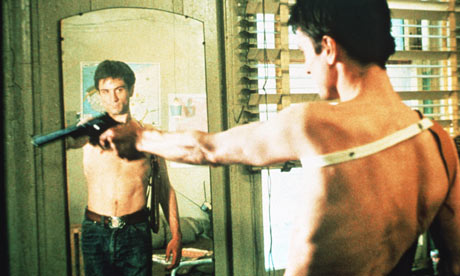
The scene I am using is the famous mirror scene featuring Robert De Niro as the schizophrenic Travis Bickle in Martin Scorcese's Taxi Driver.
The dominant in this frame is the reflection of Bickle's face in the mirror. The lighting in the frame is low key on the mirror and his reflection, but it is contrasted with a high key bright light shining on Bickle's front side. Since we are seeing two different versions of Bickle, the camera proxemics differ with each. There is an intimate shot of his actual body, while his reflection is slightly more personal. This scene is one of the first representations in the movie of Bickle's dual personality, and the framing of this shot adequately reflects his nature.
The dominant of Bickle's face is the first indication in the movie of not only his schizophrenia, but also the self-awareness of his condition. The lighting shows that the reflection he is seeing of himself in the mirror is his "dark-side", but he doesn't necessarily have a problem with this. In fact, this side of Bickle is who he truly seeks to be - the side that will go as far as to murder to protect a girl he barely even knows.
The camera proxemics at this point in the film are the indication of Bickle's other identity taking over. The entire film is a progression from one of his personalities to another, and this scene is a key moment of that transition. Aside from the famous dialogue that Bickle shares with himself ("You talkin' to me?"), this is arguably the most important scene in the film as far as character development goes.
No comments:
Post a Comment